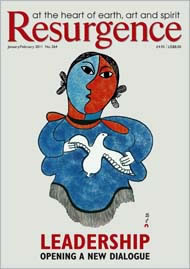Resurgence is, it’s thought, the longest-running environmental magazine in Britain. Its survival so long, without millionaire backing and without turning itself into a consumer lifestyle accessory, with the advertising to match, tells a compelling story – not only of conviction, commitment and endurance but of need, role and relevance. It was founded in 1966 by John Papworth, a well-known peace campaigner with connections to the Committee of 100 and the Peace Pledge Union, but rapidly broadened its critique from the nuclear nightmare generated by the Cold War to pollution, intensive farming and food production and the related political problems of centralisation, bigness and the growing separation of economics from ethics.
Its presiding spirits in those early days included E F Schumacher, the “renegade economist” who wrote Small is Beautiful, and Leopold Kohr, the less famous but much-admired author of the decentralist classic The Breakdown of Nations. Both wrote frequently for Resurgence, as did the self-sufficiency guru John Seymour, but despite these and many other (voluntary) contributions the magazine faced constant money problems. In the early 1970s it nearly went bankrupt but in 1973, after John Papworth had left to take up a job with the Government of Zambia and a number of “guest editors” had brought out different issues, Satish Kumar became editor – and remains to this day.
Satish is a long way from being a conventional magazine editor. He is a former religious novice, born in the Indian town of Sri Dungargarh, in Rajasthan, who became a Jain novitiate at the age of nine, remained with the monkhood until he was 18, then ran away in search of relevance, became a campaigner for land reform and in the early 1960s was fired with enthusiasm by the example of Bertrand Russell and the cause of peace. At the age of 26, he was one of two peace campaigners who walked 8,000 miles from Delhi to Washington by way of London in support of nuclear disarmament.
During Satish’s youth in India, he became imbued with the ideals both of Gandhi and another influential Indian peace worker, Vinoba Bhave, so his editorship has marked a fusion of two complementary critiques of Western developed society. From Schumacher, Papworth et al came an intellectual radicalism, with its roots in what Schumacher called “Buddhist economics.” From Gandhi, Bhave, Jainism, Rajasthan – and Satish – came not only a profound collective experience of non-violence, but a sense of timeless traditions, of the interconnectedness of life, rooted in the Indian village and the inherent practical value of work, creativity and community.
From its original base in London, Resurgence, perhaps not surprisingly in view of these traditions, moved to Wales and later to Devon, where its is now edited from Satish’s home in Hartland by a small team. Underpinning their efforts is a larger and ramifying series of connections, innovations and initiatives – from organisations ‘spun off’ from Resurgence, or started by Satish, to NGOs with which it has formed a campaigning alliance. The former include The Small School, Hartland, a successful example of human-scale education, and Schumacher College, the “green university” founded in 1990 in the grounds of the Dartington Estate in south Devon and offering year-round residential courses in subjects ranging from green business to eco-philosophy.
Another ‘companion’ organisation is the Schumacher Society, which runs the annual Schumacher lectures in Bristol, a well-known fixture in the environmental calendar. Nearby at Dartington, and part of the informal Resurgence network, is Green Books. Resurgence also has links with a wide range of NGOs including the New Economics Foundation and Friends of the Earth. The network is spreading, too – there are Schumacher lectures in Manchester now and, at Bija Vidyapeeth (School of the Seed) in the Doon Valley north India, a recently-established International College for Sustainable Living based on the model of Schumacher College.
A vital element in the Resurgence extended family, however, is its readership. There are an estimated 40,000 readers and unlike most magazines they form part of a genuine, albeit dispersed, community. If this sounds trite, one can only reply that it is true – it’s a peculiar characteristic of Resurgence, formed not only from shared, and often quite profound, allegiances, but also from regular meetings. There are Resurgence conferences and workshops, for example, as well as weekend retreats and, every August, a summer camp hosted by Green and Away in rural Worcestershire where contributors, readers, writers and editors get together in a wonderfully relaxed and informal setting – talking, eating, listening to music ... It’s at gatherings such as these that the Resurgence family becomes flesh and blood, that people discover they are not solitary voices in a hostile world – however much they sometimes think they are – and that bonds are forged, solidarities established and new friendships made. Those who take part describe them, not infrequently, as an inspiration. They’re also pretty good fun.
That, then, is Resurgence – as much family and community as magazine. You could, if you wanted to extend the metaphor, describe it as a kind of village newsletter – though the village is a global one (it has readers in 20 countries) and its Contents List extends far beyond the parish pump. But at least the idea of a village gets across its allegiance to the place we live – not merely the planet Earth but that particular bit of the Earth each individual inhabits. Resurgence is about both – the Earth we all inhabit and the Earth each one of us inhabits.








